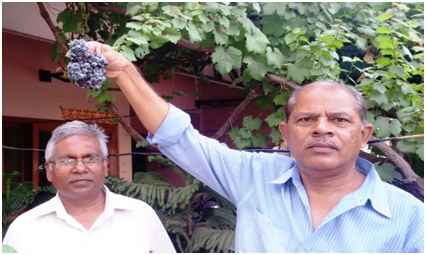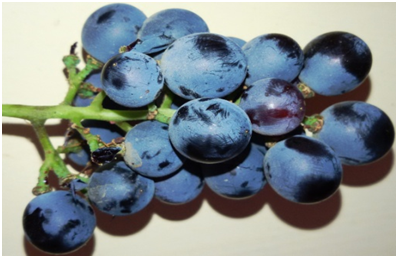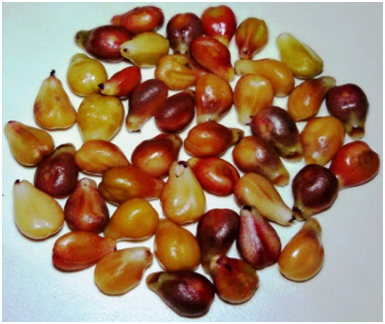eISSN: 2576-4462


Opinion Volume 1 Issue 1
Sardar vallabhbhai Patel University of Agriculture & Technology, India
Correspondence: Yogesh Prasad Rajbhar, Sardar Vallabhbhai Patel University of Agriculture & Technology, Meerut, 15011, Uttar Pradesh, India
Received: June 29, 2017 | Published: June 29, 2017
Citation: Rajbhar YP, Singh RV, Yadav AK. Scope of grape production in north india. Horticult Int J. 2017;1(1):1-2. DOI: 10.15406/hij.2017.01.00001
Grape culture is one of the most remunerative enterprises in modern India. Eminent medicine scholars as Sasruta and Charaka in their manuscripts as ‘Sasruta Samhita’ and ‘Charaka Samhita’, respectively, written during 1356-1220 BC had mentioned the enormous medicinal properties of grapes. Kautilya had also enumerated the importance of grapes in human beings in his famous manuscipts ‘Arthashastra’, during the fourth century BC. The ingenous grape species Vitis lanata and Vitis palmata grow wild in the northwestern Himalayan foothills. Even today ‘Rangspay’, ‘Shonltu White’ and ‘Shonltu Red’ the indigenous varieties are grown in Himachal Pradesh. Grapes are believed to have been introduced into the northern part of India by the Persian invaders in 1300 AD. By the Christian missionaries, it was introduced in Salem and Madurai districts of Tamil Nadu around 1832 AD. Grape is known as the Queen of the fruits as it is treasure of the health benefitting nutrients as poly phenolic antioxidants, vitamins and minerals. It is a small round berry grows in clusters on a perennial and deciduous woody vines. It is native to Europe and Mediterranean regions but now widely grown round the globe. The fruit features a semi-translucent flesh encased by smooth skin. Some varieties contain edible seeds, while others are seedless. Presence of poly-phenolic pigments in grape decides the colour as red or purple which is due to anthocyanins while white colour is due to catechin. Fortunately, these antioxidants are densely concentrated in the skin and seeds. Many cultivars of grapes are grown for different purposes either eating as a table fruit, fresh or dried as Raisin or in wine production. The grapes as European (Vitis vinifera), North American (Vitis labrusca and Vitis rotundifolia) and their hybrids are grown for different purposes. The most important variety as Thompson Seedless and its clone as Tas e Ganesh, Sonaka and Manik Chaman cover almost eighty five per cent of the area in India. Other varieties as Anab-e-Shahi, Bangalore Blue, Flame Seedless, Gulabi, Sharad Seedless, Pusa Seedless Pusa Navrang, Pusa Urvashi, etc are also grown.
Resveratrol, a polyphenol anti-oxidanthas been found in grapes has protective factor against cancers of colon and prostate, coronary heart disease, degenerative nerve disease, Alzheimer's disease and viral & fungal infections. It reduces heart attack risk by altering the molecular mechanisms in the blood vessels. Anthocyanins, an anti-oxidants, present abundantly in red grapes have anti-allergic, anti-inflammatory, anti-microbial and anti-cancer properties. Catechins, a flavonoid present in white and green varieties have health promoting effects. Besides this, these berries are very low in calories which provide 69 calories per 100 g fresh grapes but contains zero cholesterol levels. It is rich source of minerals like copper, iron and manganese. Health benefiting electrolyte, potassium is present abumdantly as 191 mg per 10-0g of pulp. It is rich source of vitamin-C, vitamin A, vitamin K, carotenes, B-complex vitamins such as pyridoxine, riboflavin and thiamin. Paneer Drakshi variety was introduced during December 2008 at Sadar Vallabvhbhai Patel University of Agriculture & Technology, Meerut -250110, Uttar Pradesh. It is very vigorous and growing well in this climatic condition. It flowers during first fortnight of March and fruits” ripen during first fortnight of June. So, it takes nearly 90 days from flowering upto harvesting. It is the earliest among all the varieties grown in northern parts the country. It bears fruits in clusters of 90-150 berries. The fruits are round in shape and dark purple in colour. The average fruit weight is 2.54g, seed weight 0.17 g and peel is 0.19 g. Its Total Soluble Solids value is 22˚brix, very sweet, pleasant and tasty. The seed is very soft which is very crispy in nature. It is very vigorous in vine which needs Arbour or Pergola system of training. It may be boon for growers of northern Indian condition where they face problem of late ripening which coincides with the monsoon resulting splitting of fruits and ultimately decay of the whole produce. The average fruit yield is 100-120 kg per vine at nine year age which shows the tremendous scope of its exploitation in this region by planting it at 3x3m apart.




None.
The author declares no conflict of interest.

©2017 Rajbhar, et al. This is an open access article distributed under the terms of the, which permits unrestricted use, distribution, and build upon your work non-commercially.